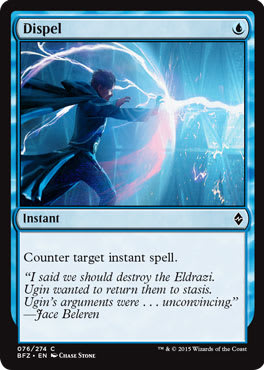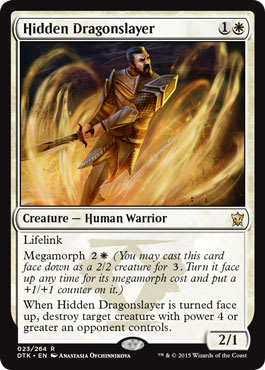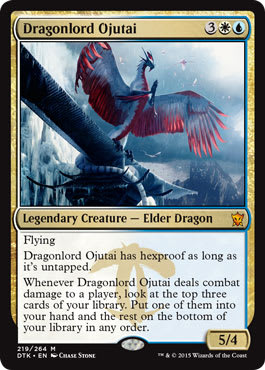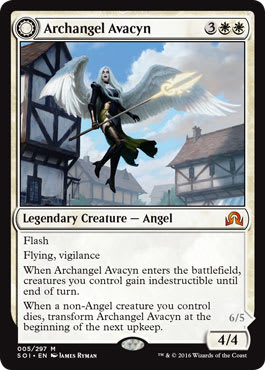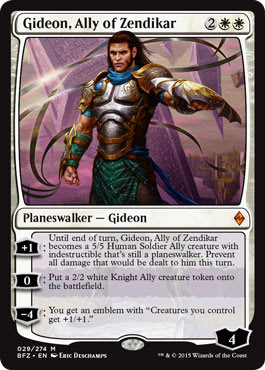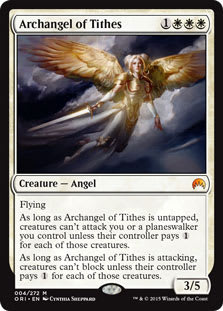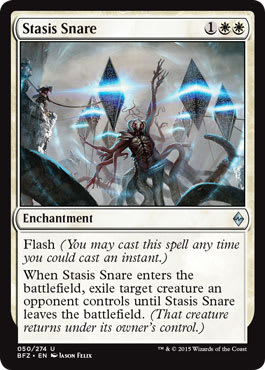The first weekend of Shadows over Innistrad Standard is in the books, and I am over the moon. Last week, I provided a bit of insight into some things that my testing group had learned without being too specific with archetypes that we were playing or giving out crucial information that could come back to bite us.
The cat is out of the bag now:
W/u Humans ? Shadows over Innistrad Standard | Emma Handy, StarCityGames.com Circuit Series Open, 14th Place
- Creatures (31)
- 2 Archangel of Tithes
- 3 Expedition Envoy
- 3 Reflector Mage
- 4 Consul's Lieutenant
- 4 Dragon Hunter
- 4 Knight of the White Orchid
- 4 Thalia's Lieutenant
- 4 Thraben Inspector
- 3 Kytheon, Hero of Akros
- Spells (7)
- 3 Declaration in Stone
- 4 Always Watching
- Lands (22)
- 13 Plains
- 1 Westvale Abbey
- 4 Port Town
- 4 Prairie Stream
- Sideboard (15)
- 2 Negate
- 2 Archangel Avacyn
- 2 Gideon, Ally of Zendikar
- 2 Lantern Scout
- 1 Westvale Abbey
- 1 Archangel of Tithes
- 1 Stasis Snare
- 1 Eerie Interlude
- 1 Invasive Surgery
- 1 Declaration in Stone
- 1 Reflector Mage
There is a lot going on in this list (despite having the appearance of an average White Weenie variant), and before delving too deep into that, we’re going to take a look at how I arrived at this particular list. Having a team was absolutely crucial in arriving at this list, as it may appear to be a simple week-one deck, but it is the result of hours of testing, tweaking, and rebuilding—faster, stronger than ever before. We have the tech—never mind, I’m getting too caught up in my own joke. In lieu of a ’70s TV reference, let’s get into the process that led to the finalized decklist.
Very early into brainstorming deck ideas, Team Bolas decided that, for group playtest sessions, everybody would bring a tier-one deck that everyone needed to playtest against and a tier-two deck or brew to try out. My two decks were Bant Company (as mentioned here) as the tier-one list and a (nearly-) mono-white Humans list:
R/W Humans ? Shadows over Innistrad Standard | Emma Handy
- Creatures (26)
- 3 Hidden Dragonslayer
- 4 Consul's Lieutenant
- 4 Dragon Hunter
- 4 Expedition Envoy
- 4 Knight of the White Orchid
- 4 Thalia's Lieutenant
- 3 Kytheon, Hero of Akros
- Planeswalkers (2)
- 2 Gideon, Ally of Zendikar
- Spells (9)
- 1 Secure the Wastes
- 4 Declaration in Stone
- 4 Always Watching
- Lands (23)
- 13 Plains
- 2 Westvale Abbey
- 4 Battlefield Forge
- 4 Needle Spires
The driving idea behind the deck was the most basic White Weenie strategy out there: Play creatures, go wide, play some Anthems, and hope it’s enough. Needle Spires was the only “splash” in the deck because of how well it played with the various Anthems in the deck. Hidden Dragonslayer performed rather poorly, and some of the cards higher on the curve (Secure the Wastes and Gideon, Ally of Zendikar) ended up playing awkwardly a large portion of the time.
After a few hours, Ali Aintrazi suggested adding Reflector Mage to the deck, and the deck took on a very different role through some seemingly subtle changes:
W/u Humans Rough Draft ? Shadows over Innistrad Standard | Emma Handy
- Creatures (27)
- 4 Dragon Hunter
- 4 Expedition Envoy
- 4 Hanweir Militia Captain
- 4 Knight of the White Orchid
- 4 Reflector Mage
- 4 Thalia's Lieutenant
- 3 Kytheon, Hero of Akros
- Spells (8)
- 2 Declaration in Stone
- 2 Silkwrap
- 4 Always Watching
- Lands (21)
- 13 Plains
- 4 Port Town
- 4 Prairie Stream
Brainstorming a bit more and getting in some mock games with the deck over the internet forced a handful of things became clear to me: Declaration in Stone is great, Silkwrap may be a liability against a bunch of Dromoka's Commands, and Westvale Abbey was missed from the first list.
With only two days until the team converged in a single location, I settled on the following main deck and sideboard to start practicing with the archetype:
W/U Humans Second Draft ? Shadows over Innistrad Standard | Emma Handy
- Creatures (27)
- 2 Hanweir Militia Captain
- 4 Consul's Lieutenant
- 4 Dragon Hunter
- 4 Expedition Envoy
- 4 Reflector Mage
- 4 Thalia's Lieutenant
- 2 Anafenza, Kin-Tree Spirit
- 3 Kytheon, Hero of Akros
- Spells (7)
- 4 Declaration in Stone
- 3 Always Watching
- Lands (22)
- 13 Plains
- 1 Westvale Abbey
- 4 Port Town
- 4 Prairie Stream
- Sideboard (15)
- 3 Negate
- 1 Dispel
- 3 Gideon, Ally of Zendikar
- 2 Archangel Avacyn
- 1 Meandering River
- 2 Stasis Snare
- 3 Lantern Scout
The first testing session went incredibly well for Humans, with the deck boasting something in the area of a 70% win rate against Vampires, U/B Reanimator, Jund Gitrog, Dragons, Tokens, W/B Control, Esper Control, and U/R Madness. The deck tended to have trouble against decks that were just piles of removal, and sideboading out a majority of the 1-drops turned out to be incredibly important against W/B Control and U/R Madness.
Archangel Avacyn overperformed over the course of the weekend, and so did Westvale Abbey. I had noticed Dispel stranded in my hand against a lot of the slower decks that weren’t Esper. Lantern Scout was incredibly powerful against Tokens and Vampires.
One aspect of games that I very quickly noticed was how powerful the first strike mechanic was. There were board stalls between a good number of the decks that were just being dominated by Consul's Lieutenant and Knight of the White Orchid because my opponents couldn’t profitably attack into them or block them.
The second group playtest sessions were a bit stranger in format but helped streamline certain aspects of the Humans tuning. Despite everybody being able to show up at a predetermined location on the same day, very few people actually had schedules that lined up to be able to play simultaneously. This led to there never being more than four Team Bolas members present at once despite everybody being present at some point or another.
While this made it a bit harder to jam too many games in a row with the deck, it did give me a large amount of time to go over the deck and the deck’s construction with Dalton Ozmun. His first inclination when making changes to the deck was to test out Thraben Inspector as another 1-drop to make Kytheon, Hero of Akros and the various Glorious Anthem–esque abilities more explosive. I was incredibly wary of playing a 1/2 for 1 in an aggressive strategy, but I trusted his judgment.
Dalton also was insistent on wanting to try out Archangel of Tithes. His insistence that it was exactly what the deck needed made sense when he pointed out how good it was against the various Collected Company decks, its resistance to Languish, and the synergy the Angel has with Always Watching. The Archangels came at the cost of a pair of interactive spells in the main deck. Many hands were clogged with too many ways to interact with creatures that weren’t proactive enough on their own. These types of draws sacrifice very real percentage points Game 1, when the strategy is to be as streamlined as possible and just try to kill the opponent. This led to something close to our final list:
W/u Humans ? Shadows over Innistrad Standard | Emma Handy
- Creatures (31)
- 2 Archangel of Tithes
- 3 Reflector Mage
- 3 Thraben Inspector
- 4 Consul's Lieutenant
- 4 Dragon Hunter
- 4 Expedition Envoy
- 4 Knight of the White Orchid
- 4 Thalia's Lieutenant
- 3 Kytheon, Hero of Akros
- Spells (7)
- 3 Declaration in Stone
- 4 Always Watching
- Lands (22)
- 12 Plains
- 2 Westvale Abbey
- 4 Port Town
- 4 Prairie Stream
- Sideboard (15)
- 1 Declaration in Stone
- 1 Hidden Dragonslayer
- 2 Negate
- 1 Hallowed Moonlight
- 3 Gideon, Ally of Zendikar
- 2 Archangel Avacyn
- 1 Westvale Abbey
- 3 Lantern Scout
- 1 Silkwrap
The main deck was putting up incredible numbers for the first game each match, but it was having a bit of trouble after sideboard. The team had more or less identified that Humans was the best aggressive strategy, and teammates were tuning their decks and sideboards accordingly. It was worrisome to have an 80% win rate pre-’board and a 30% win-rate post-’board. Weird sideboard strategies started being tested. These are all cards that ended up in my Humans sideboard in testing online or with teammates at some point:
I had Bant Company (a list very similar to the streamlined variant from my previous article) and was worried I would have to fall back on a deck that I felt was weaker but that had better sideboard strategies against an unknown field. Very late into preparation, fellow Team Bolas member Geoff Mullin suggested a W/U Midrange list to me that had been floating around the internet. The deck had a similar feel to Humans but went bigger. His main selling point was that it played the Avacyn and Gideon strategy that I had become so hooked on.
Something clicked.
Playing the same Humans strategy Games 2 and 3 wouldn’t work. When going into a tournament for the first week of Standard, people are forced to generalize as many of their cards as possible and answer things on the fly. This means people aren’t as prepared for a deck to shift its game plan. Enter the transformational sideboard:
W/u Humans ? Shadows over Innistrad Standard | Emma Handy, StarCityGames.com Circuit Series Open, 14th Place
- Creatures (31)
- 2 Archangel of Tithes
- 3 Expedition Envoy
- 3 Reflector Mage
- 4 Consul's Lieutenant
- 4 Dragon Hunter
- 4 Knight of the White Orchid
- 4 Thalia's Lieutenant
- 4 Thraben Inspector
- 3 Kytheon, Hero of Akros
- Spells (7)
- 3 Declaration in Stone
- 4 Always Watching
- Lands (22)
- 13 Plains
- 1 Westvale Abbey
- 4 Port Town
- 4 Prairie Stream
- Sideboard (15)
- 2 Negate
- 2 Archangel Avacyn
- 2 Gideon, Ally of Zendikar
- 2 Lantern Scout
- 1 Westvale Abbey
- 1 Archangel of Tithes
- 1 Stasis Snare
- 1 Eerie Interlude
- 1 Invasive Surgery
- 1 Declaration in Stone
- 1 Reflector Mage
A majority of games in the tournament involved switching ten cards between the main deck and sideboard to catch the opponent offguard.
Out:
In:
These numbers could change from matchup to matchup (the combination of Thalia’s and Consul's Lieutenant shifted a good bit depending on the opponent’s density of 2-toughness creatures that first strike was relevant against), but this is the basis of the deck itself. There were probably half-a-dozen or more games that were near-free wins because opponents had underpowered cards like Flaying Tendrils, Tide Drifter, and Silkwrap when my plan was to turn the games into a sort of midrange war.
The configuration of the deck was a bit underpowered for a deck, but it is a much better strategy when many opponents ended up having eight or more virtually dead cards or near-misses in their decks. “Forcing” an opponent to using Flaying Tendrils against a pair of Knight tokens and a Thraben Inspector is a pretty great feeling. While I am not entirely confident the plan will work multiple weeks in a row, it made a great showing this weekend and will be a strong consideration for next week.
I am generally pretty opposed to overall sideboard guides, but I am going to outline the different roles of cards in the sideboard and some of the weaker cards in the main deck:
The Main Deck
The Dragon Hunters and Expedition Envoys come out a large chunk of the time. Savannah Lions sure isn’t what it used to be, and these are the cards people have the most effective hate for. It’s downright embarrassing to control multiple 2/1s when an opponent resolves a Secure the Waste for any number higher than the number of 2/1s you have.
Reflector Mage is fantastic but does come out in a nonzero number of matchups. Against Esper Dragons, it is incredibly underpowered. Reflector Mage is actually a liability against a good number of the W/B Wasteland Strangler/Tokens decks. If you find the Man-o'-War-turned-Meddling Mage just acting as an over costed Elvish Warrior, don’t be afraid to take it out.
The values of Thalia's Lieutenant and Consul's Lieutenant are almost directly proportional with the number of other creatures that you have to pair with them. In matches with a lot of 2-toughness creatures or creature combat, Consul's Lieutenant shines as a French vanilla 2/1 creature with first strike. Thalia's Lieutenant tends to shine more against decks that play a lot of one-for-one removal. Casting Thalia's Lieutenant to “leave behind” power and toughness even if the opponent has removal is a way to gain incremental bits of value as the game progresses.
The Sideboard
Archangel Avacyn is the most powerful card in the deck by a significant margin. She may also be the hardest card to play with. Casting Avacyn for value (to protect your creatures from a removal spell or set up favorable blockers) is generally what the deck aims to be doing in post-sideboarded games. The clock she provides by herself is absurd, and the subgames that come with her make her a very welcome addition to the archetype. There are a handful of matches in which I didn’t bring her in on the play (as I want the curve to stay as low as possible in some places), but I may have been a bit overcautious in those cases.
Last week, I had an entire section of my article dedicated to how poorly positioned Gideon, Ally of Zendikar was against a majority of the format, and I proceeded to play multiple copies in my seventy-five to an exceptional finish at the tournament. The biggest reason for this is that the cards that are good against Gideon aren’t very good against the Humans deck, and the cards that are good against his Knight friends tend to be cards that Humans has to bring in answers for anyway. I still am of the opinion that Gideon is a bit overplayed (just glancing over the decklists from the Top 64 of the tournament), but he felt correct in this context.
Lantern Scout was completely unnecessary. I ’boarded it in zero times, crushed a majority of my aggro opponents, and wish I had had a different pair of cards in my sideboard.
Invasive Surgery may stick out to some players as a card that is narrow and underpowered. In this archetype, delirium is never going to be enabled, and Negate is generally a more powerful Magic card. In playtesting, I found myself with Negates clogged in my hand without the mana to cast multiples, and there were many times I didn’t want to bring in too many Negates, as it makes the curve relatively awkward to have a pile of 2-drops and be stuck on 3 mana (not an uncommon occurrence). Invasive Surgery is just used as the card Envelop to counter Languish, Radiant Flames, Painful Truths, Descend Upon the Sinful, Declaration in Stone, and Ruinous Path. The card was exceptional for me all weekend, and there’s a strong chance I end up playing more this weekend.
Archangel of Tithes’s value cannot be overstated. She breaks the mirror, doesn’t die to Languish, and can interact favorably against Archangel Avacyn in combat. Be very prepared with or for this card going forward. She is going to be a role-player.
Stasis Snare was the easiest catch-all answer that dealt with Archangel Avacyn. It ended up playing other roles, but its primary focus was taking 4/4 flying creatures with flash and indestructible out of the way.
The Declaration in Stone and Reflector Mage in the sideboard were to up the numbers of the cards that were best in pseudo-mirrors. Reflector Mage is amazing against other creatures decks (doubly so against ones that don’t play anything with morph) and ensures its controller stays ahead on board. Declaration in Stone ensures the Humans deck will always be “wider” than the opponent. Generally, the only way for non-Humans decks to have more blockers than the Humans deck has creatures is to have tokens, so being able to take a handful of tokens out of the way is fantastic. Declaration in Stone probably exiled forty or more Thopters over the course of the weekend. Never leave home without a full playset in the seventy-five.
Eerie Interlude was an answer to decks that played a bunch of sweepers that Humans wanted to remain low to the ground against. Ramp was a deck that the transformational sideboard does very poorly against, and Eerie Interlude is among the only reasonably costed ways to beat the “flashback” on Kozilek's Return.
The second copy of Westvale Abbey was moved to the sideboard because it is catastrophic to draw two copies of it Game 1. There isn’t anything in the main deck with more than a single generic mana in the mana cost, so it is almost the same as skipping a draw step or being on a pseudo-mulligan.
I reached out on Twitter for any questions that people may have on the deck and wanted to go ahead and throw those in before my editor kills me for submitting a memoir to him—
@Em_TeeGee without giving away too many edges, what's next week's humans tech and what's the keys in the mirror?
— Zach Cramer (@MTGZach) April 12, 2016
Archangel of Tithes, Archangel Avacyn, and Declaration in Stone are the most important cards in the mirror. Dromoka's Command is also quite powerful (out of the G/W variants of Humans), as it can destroy Always Watching midcombat.
@Em_TeeGee Looking forward to it! Would love to know why you decided on a bunch of Savannah Lions over a higher curve/more powerful cards
— Eliot Johnson (@Hind_Catcher) April 12, 2016
I do what I can to try and be a “best-deck player,” and I tend to lean toward aggressive strategies doing proactive things. Humans had a great win rate in our gauntlet, and I didn’t want to throw my tournament away by picking contextually bad, albeit powerful, cards. One of my favorite phrases in Magic is, “It doesn’t matter how good the cards in the opponent’s hand are if that player is at 0 life.”
@Em_TeeGee Why U/W vs G/W or mono-white
— ziggy nix (@ziggymondais) April 12, 2016
Honestly, I’m very high on Negate right now and think it and Reflector Mage are better than anything green has to offer. I also think that, going forward, mono-white is very risky. It was great this week because it is very low to the ground and aggressive, but Humans had an enormous showing this week. It makes the variants that are very low to the ground (without a lot of disruption) a bit more suspect going forward. I quite liked Dwayne Graham’s G/W list from the Top 8.
@Em_TeeGee What are your good match ups?
— Hewlett (@LeHewlett) April 12, 2016
What are your bad match ups?
I would estimate the deck’s best matchups are decks relying too heavily on Thought-Knot Seer and Gideon, Ally of Zendikar. Those cards just do not interact on an axis that W/u Humans cares about very much.
The decks that are scariest are the decks that just play endless streams of removal. The Gitrog Monster shells can be a bit bothersome. If the opponent can answer your Angels, that player can generally deal with everything else as well.
Going forward, I am not certain Humans is the best deck to play, as it has a pretty large target on its back after the great showing it had this weekend. If I were to have any strong recommendations for the deck, they would be to overvalue Angels, undervalue Elite Vanguard variants, and don’t play Lantern Scout. If you have any questions that weren’t answered here or just want to talk about Humans some more, feel free to post a comment below, and I will absolutely get back to you! Thanks a lot for reading!
Bonus Questions & Story
@Em_TeeGee just how cute were those boys around you when you decided to go all in?
— Dalton Ozmun (@DaotonMTG) April 12, 2016
This is in reference to a situation on Day 1 of competition. I was deep in the tank over how far to extend into a possible sweeper—or whether to extend anything else at all. My opponent and I had received a deck check that took a long time, so we were coming near time in the round. My opponent made some offhand comment to the effect of, “Starting to come close to a decision?” I paused, looked around at the crowd of people watching us, and declared, “Well, there are a lot of cute boys watching, and I don’t wanna disappoint them.” I proceeded to play every single creature in my hand, to which my opponent had no sweeper, and he died the next turn. It made for a pretty good laugh with my opponent and the people watching.















